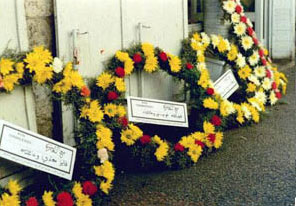Human Flower Project
Monday, January 02, 2006
Ramallah’s Flowers—Checkpoints and Desire
In the midst of the second intifada (uprising), flower-giving takes hold in Palestine.
 Market at Qalandiyah,
Market at Qalandiyah,
checkpoint between
Jerusalem and Ramallah
Photo: Media Mouse
An intriguing and rare piece of journalism, by Amira Hass, gets beneath the surface of business reporting to deliver a full blown human flower project. Hass’s article in Haaretz explores the fast-changing flower customs of Ramallah, (pop. 24,000) a city on the West Bank, about 10 miles north of Jerusalem. We see how floral practices belie the “facts” of police blotters and pronouncements of governments.
Ramallah has long been a cultural center with a strong community of Christian Arabs. In the 1960s, the city had only one florist: Ramallah Flowers “opposite the Dunia Cinema and the Grand Hotel.” Its owner, Farhan Ma’arouf, was renowned for his discretion and skill, and for his glorious wreaths of flowers woven “with branches of cypress and lemon.” The family once had its own nurseries in Jericho, but after 1967 began buying most of their flowers in Israel, finding, “It was hard to compete with the quantities and the variety” though they still added blooms from their own greenhouses for “a personal touch.” Farhan’s son Amin carried the business on, but the shop closed in 1988.
Today, there are seven florists in Ramallah, and Hass observes they “look like flower shops anywhere.” Two rather new customs have emerged in Ramallah: bringing flowers to hospital patients (never considered even ten years ago) and presenting bouquets to lecturers, composers and musical soloists at the local arts center. Hass writes that last spring, a bouzouki player made music in keeping with Ramallah’s recent history. “There was a lot of fury, anger and melancholy in his melodies, but the bouquet he received was cheerful.”
 Wreaths in Ramallah
Wreaths in Ramallah
Photo: Nigel Parry
How could flower-giving be catching on in a land of huge unemployment and violence? Greenhouses have been bulldozed. The checkpoints that surround Ramallah impede how both people and flowers move through the region.
“If someone orders a dark pink flower arrangement from me, and I order the flowers by phone and can’t see them with my own eyes, I could very well get purple flowers that I didn’t want. How can I fulfill the order?” Amin Ma’arouf asks. Popular flowers like anemones are delicate, too delicate for the long delays in delivery that, under current restrictions, have become the norm; the people of Ramallah are carrying on with chrysanthemums and carnations instead.
But Hass notes that restrictions on movement have had another effect—inducing wealthier professionals, like teachers and government officials, to move from outlying areas into Ramallah itself. They bring their money and their tastes with them, tastes which, Hass writes, “have seeped from one group to another – from Christians to Muslims, from veteran urbanites to new city-dwellers, from the upper middle class to the lower middle class.”
Sociologist Lisa Taraki says that the city’s reputation for tolerance has attracted a middle class which in turn, “nurtures and shapes the character of the city.” What is this character? Hass writes, “The drama inherent in the desire and ability to buy flowers, to adopt and develop a new and not inexpensive custom is that bereavement, death and the economic low of recent years have not engendered a culture of asceticism.” Bouquets of fresh gladiolas prove that.
Flowers may not bring peace to the region, but they are like canaries still singing in a coal mine. They point from extremism toward something more complex, alive.
Culture & Society • Florists • Politics • Secular Customs • Permalink




